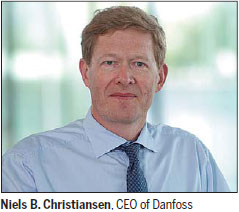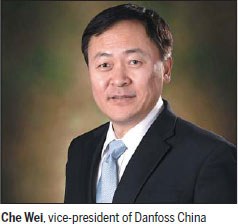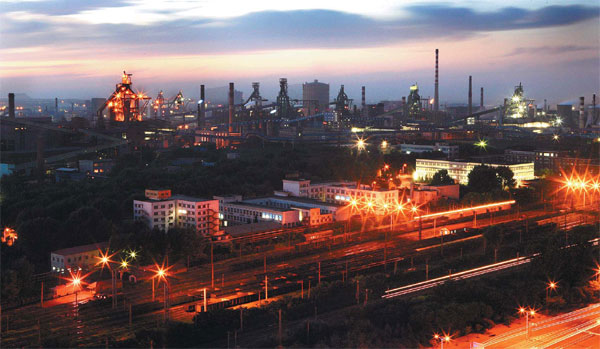The miracle in Anshan
Updated: 2015-02-20 09:28
By Fu Jing(China Daily Europe)
|
|||||||||||
Following advice of a Danish multinational, a city in Liaoning province is tapping into the surplus heat from a local steelmaking facility to provide heat to 3.8 million residents
Premier Li Keqiang famously said in Brussels that once Europe creates environmentally friendly and cutting-edge economic solutions that can benefit China's markets, miracles will happen.
A key industrial facility in Anshan, Liaoning province, that is putting the experience and technology of a Danish multinational into practice, is illustrating the truth in Li's statement.
For years, about 3.8 million residents in this polluted industrial city, home to the world's seventh-largest iron and steel company, have primarily burned coal - a major source of air pollution - to provide heat during the winter.
But little did residents know that the steelmaking facilities of Anshan Iron and Steel Group Corp within their city borders were producing a tremendous amount of heat that was not being utilized.
Things began turning around for the city when Danfoss, a multinational from Denmark renowned for its energy-efficient cooling and heating technology, partnered with Denmark's energy consulting group COWI to analyze Anshan's environmental and industrial challenges.
The two persuaded the Anshan government to use surplus heat from Ansteel's facilities as the city's primary energy source, thereby transforming the city's heating supply. The Anshan government built a transmission system that funneled heat from Ansteel to the city's heating networks.
"I think this is an excellent example of helping to improve energy efficiency and urbanization in a sustainable way," says Che Wei, vice-president of Danfoss China. "We are making efforts to identify other projects in China to expand our expertise and experience."
Buildings are also equipped with meters to ensure that each building receives an adequate supply of heat.
According to Danfoss, the pilot project can potentially reduce the annual coal consumption by 173,000 metric tons and reduce carbon dioxide emissions by 289,000 tons, covering half of the urban population.
"With an expected payback time of three years, the financial prospects are very positive," says Che.
And full implementation would lead to annual coal savings of 678,000 tons and avoid emission of 1.38 million tons of carbon dioxide, corresponding to 60-90 percent in coal and CO2 emissions. Che says the transformation can also reduce particle pollution, which improves the air quality for almost 4 million citizens. "In this sense, we have very good cooperation and communication with local authorities, which has already put environmental protection and energy savings high on agenda," he says.
Che says the Anshan case is a perfect encapsulation of the Danish green development model. Resource-poor Denmark has been able to decouple economic growth from energy consumption and excessive CO2 emissions in the past four decades since the global oil crisis of the 1970s. Denmark is also on track to achieve a fossil energy-free future by 2050 without the use of nuclear power, officials say.
Niels B. Christiansen, CEO of Danfoss, says the company is looking to expand its experiences in Anshan throughout China.
"The great ambition among Chinese leaders is one of the main reasons why today we have some of our most highlighted energy efficiency cases in China," says Christiansen, who says Danfoss first came to China almost 20 years ago.
The Danfoss Group is a global company, whose main products and services include refrigeration, air conditioning, the control of electric motors, cooling and heating for buildings and renewable energy. The company is active in the solar and wind power industries as well as in constructing heating and cooling infrastructure for cities and urban communities.
The Danfoss CEO says the Chinese leadership has put great emphasis on long-term sustainable growth and economic quality.
"I think that matters, and we are the kind of company that wants to see long-term growth with sustainability. I think that's fundamentally important," says Christiansen. "What I've heard is that growth in China will be a bit lower, but that the quality of growth will be higher. I think that's very wise."
He says Danfoss sees China as an important market and is planning to invest more in the country, the third-largest market for the company in the world. Among countries where Danfoss has established a presence, China has the second-highest number of employees and is its largest sourcing market.
Christiansen says it's encouraging to see that in the last year of China's 12th Five-Year Plan (2011-2015), the country is aiming to accelerate urbanization sustainably.
"This is a very good match for our ambitions as a company: To help the world, and certainly China, and make more with less in areas such as food, energy, infrastructure and the environment," says Christiansen.
He adds that China has been efficient in tackling these issues, though the country "knows how to do better. In some of the areas that we have talked, you can say China can learn".
"The improved awareness will also bring opportunities for companies like us. That's why I think it's very positive," says Christiansen, who adds he travels to China at least three times a year.
His suggestion for China in improving how it tackles climate change is to better manage the waste produced by a city and develop technologies that can recycle the waste into useful resources.
"Those are the type of things we can do," he says.
Christiansen says Danfoss has been pushing for innovation in China for several years, and in the past three to five years, government officials have spoken more fervently about the transfer of high technology.
"Now I think that fits well," says the Danfoss CEO, who adds that the company has hired more engineers in China over the past seven years.
"The timing is perfect and I think it's nice to see that China is taking off. We are ready to provide solutions in China and for China," he says.
Christiansen says Europe should follow China's example in its economic structural reforms.
"There are many things Europe can learn from China, and China has a lot to learn from Europe, too. I think it has to do with speed, the speed of making decisions," he says.
Liu Jia contributed to this story.
fujing@chinadaily.com.cn



|
Buildings in Anshan are becoming more energy efficient. |
|
A view of the Danfoss Anshan project, which uses surplus heat from steelmaking to heat homes. Photos provided to China Daily |
(China Daily European Weekly 02/20/2015 page16)
Today's Top News
Austria on alert following Denmark terror attacks
Rouble's fall to hurt weather forecast: Meteorological center
S Korea top choice for Chinese holidaymakers
UN Security Council slams IS murders of 21 Egyptians
Danish police kill gunman suspected of shootings
Michele Ferrero, maker of Nutella, dies on Valentine's Day
Italy closes Libyan embassy
8th Europe-Ukraine Forum held
Hot Topics
Lunar probe , China growth forecasts, Emission rules get tougher, China seen through 'colored lens', International board,
Editor's Picks

|

|

|

|

|

|







